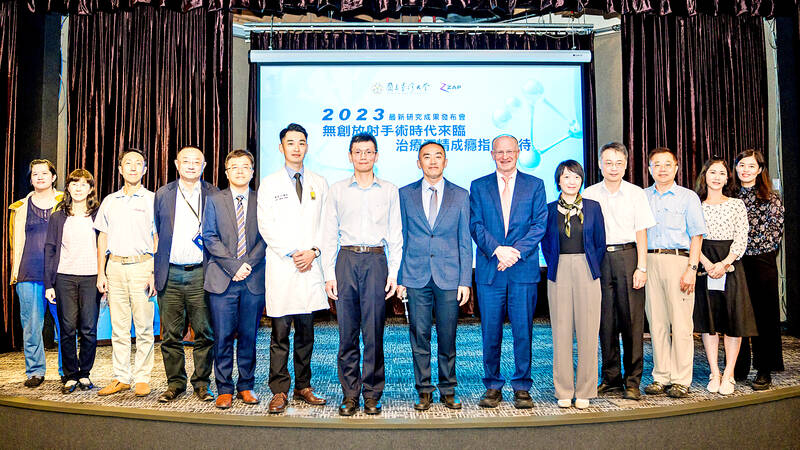National Taiwan University (NTU) yesterday said a research team, in collaboration with researchers from Taichung Veterans General Hospital and a US medical equipment manufacturer, developed a noninvasive radiosurgery system that has shown potential for treating alcohol addiction in animal experiments
Research project leader Yeh Chun-i (葉俊毅), an assistant professor at NTU’s Department of Psychology, said that alcohol is the most widely abused substance and accounts for about 91 percent of substance addiction cases, as studies suggest about 10 percent of people with long-term alcohol use might develop an addiction.
People with alcohol addiction might find themselves unable to control compulsive alcohol drinking, and it could lead to negative health and societal effects, including increased risk of cancer, liver disease and depression, as well as drunk driving, job loss, divorce and damaged family relationships, he said.

Photo courtesy of National Taiwan University
Common treatments for alcohol addiction are medication and cognitive behavioral therapy, but the effects are still limited, so some studies are turning to noninvasive neuromodulation to treat addiction, Yeh said, adding that their team developed a stereotactic radiosurgery therapy.
The therapy can deliver a low dose of acute radiation to a certain area of the brain to alter neural activity, and the low dosage is relatively free from harming the brain, he said.
Yeh said the team conducted the experiment on three pigs for two years, allowing them to press a button to drink alcohol, and that on average, they had drunk about 1.5 times the average amount as human adults who engage in excessive drinking, causing the pigs to develop an alcohol addiction.
After performing the therapy once on the pigs, the amount of alcohol intake from their voluntarily alcohol drinking reduced by 30 percent in one to three months, and then by 45 percent in seven to nine months, he said, adding that the nucleus accumbens in their brain showed no significant changes, indicating no adverse side effects.
He said that the pigs with alcohol addiction showed lower connectivity between the nucleus accumbens and cingulate cortex, but after receiving the stereotactic radiosurgery, the connectivity was partially recovered.
NTU College of Medicine’s Institute of Medical Devices and Imaging assistant professor Xiao Fu-ren (蕭輔仁), who is also a neurosurgeon at NTU Hospital, said radiosurgery was mainly used for destroying tumors in the brain as a cancer treatment, but the primary finding of their research showed that it has the potential to treat alcohol addiction or other diseases.
Additional reporting by CNA

An essay competition jointly organized by a local writing society and a publisher affiliated with the Chinese Communist Party (CCP) might have contravened the Act Governing Relations Between the People of the Taiwan Area and the Mainland Area (臺灣地區與大陸地區人民關係條例), the Mainland Affairs Council (MAC) said on Thursday. “In this case, the partner organization is clearly an agency under the CCP’s Fujian Provincial Committee,” MAC Deputy Minister and spokesperson Liang Wen-chieh (梁文傑) said at a news briefing in Taipei. “It also involves bringing Taiwanese students to China with all-expenses-paid arrangements to attend award ceremonies and camps,” Liang said. Those two “characteristics” are typically sufficient

A magnitude 5.9 earthquake that struck about 33km off the coast of Hualien City was the "main shock" in a series of quakes in the area, with aftershocks expected over the next three days, the Central Weather Administration (CWA) said yesterday. Prior to the magnitude 5.9 quake shaking most of Taiwan at 6:53pm yesterday, six other earthquakes stronger than a magnitude of 4, starting with a magnitude 5.5 quake at 6:09pm, occurred in the area. CWA Seismological Center Director Wu Chien-fu (吳健富) confirmed that the quakes were all part of the same series and that the magnitude 5.5 temblor was

The brilliant blue waters, thick foliage and bucolic atmosphere on this seemingly idyllic archipelago deep in the Pacific Ocean belie the key role it now plays in a titanic geopolitical struggle. Palau is again on the front line as China, and the US and its allies prepare their forces in an intensifying contest for control over the Asia-Pacific region. The democratic nation of just 17,000 people hosts US-controlled airstrips and soon-to-be-completed radar installations that the US military describes as “critical” to monitoring vast swathes of water and airspace. It is also a key piece of the second island chain, a string of

The Central Weather Administration has issued a heat alert for southeastern Taiwan, warning of temperatures as high as 36°C today, while alerting some coastal areas of strong winds later in the day. Kaohsiung’s Neimen District (內門) and Pingtung County’s Neipu Township (內埔) are under an orange heat alert, which warns of temperatures as high as 36°C for three consecutive days, the CWA said, citing southwest winds. The heat would also extend to Tainan’s Nansi (楠西) and Yujing (玉井) districts, as well as Pingtung’s Gaoshu (高樹), Yanpu (鹽埔) and Majia (瑪家) townships, it said, forecasting highs of up to 36°C in those areas